Rome was once the capital of the Roman Empire, one of the largest empires in world history. It was the first city to have running water and the first to hit one million residents. Fast forward to the 21st century and Rome is still one of Europe’s most iconic cities for ancient history lovers and romantics alike. However, it is also Italy’s busiest city. Rome sees millions of tourists every day and also has a permanent local population of just over 4 million residents.
While the Spanish Steps, the Trevi Fountain, and of course the Colosseum are rarely without large tourist crowds, Rome manages to have quieter spaces with greenery and shady trees. From the large Villa Borghese (pictured above) to off-the-beaten-path terraces, simply finding these peaceful nooks is half the fun. These green spaces do not sacrifice history either. A visit to each destination incorporates historic structures large and small while taking you to multiple corners of the Eternal City.
Relax on park benches surrounded by trees and grass
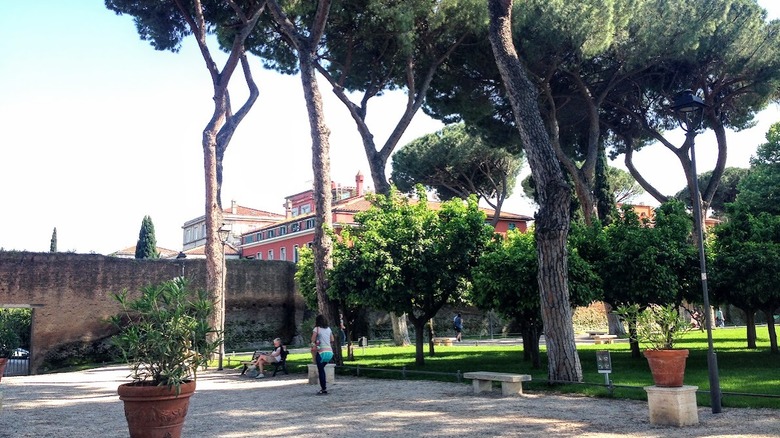
On the west side of Rome’s Circus Maximus (Circo Massimo) ruins, the winding streets of Clivo di Rocca Savella or Clivo dei Publicii lead to Giardino degli Aranci (Orange Garden). Not only does this garden have tall shady trees and park benches, but it also has a lovely view of the city reaching all the way to Altare della Patria near the forums. The Basilica di Santa Sabina all’Aventino next to this garden was first built in the 5th century and still holds mass on Sunday mornings. It is open to the public after these services from noon to 7 p.m. on Sundays and Mondays and from 8 a.m. to 7 p.m. on all other days of the week.
Continue on Via di Santa Sabina to the other side of Basilica di Santa Sabina all’Aventino, where you will find Giardino di Sant’Alessio. While this garden and its neighboring churches are lovely, the street’s claim to fame is the Buco della serratura dell’Ordine di Malta, a small keyhole opening with a direct view of St. Peter’s Basilica (Basilica di San Pietro). However, the secret is out and there will likely be a line to look through the opening.
Look for fountains and sculptures in Villa Borghese
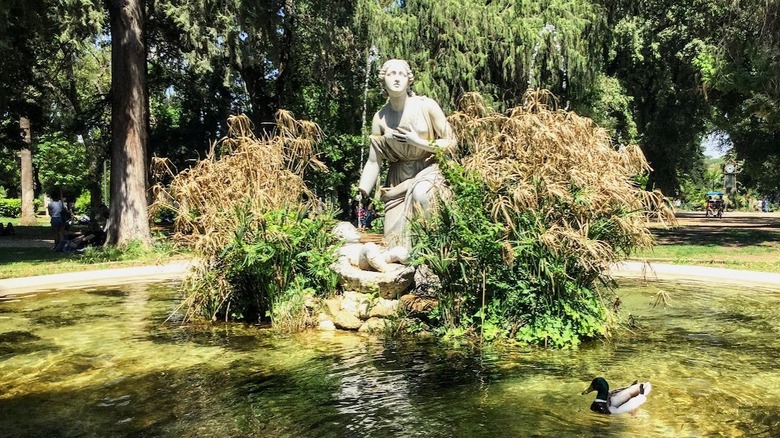
North of Rome’s central attractions is the Piazza del Popolo. Aside from being a large pedestrian plaza, the stairs on its west side lead up to a terrace overlooking the piazza and all the way to St. Peter’s Basilica. After taking in this view, head toward the trees behind you to reach Villa Borghese. This park area is peaceful but sprinkled with hidden gems like a treasure hunt. One of the most heavenly spots in Villa Borghese is the Temple of Aesculapius (Tempio di Esculapio) and the pond in front of it. Aesculapius was the Greek god of medicine and healing but was incorporated into Roman culture just like so many other Greek gods and goddesses.
While strolling along Villa Borghese’s wooded paths, keep your eyes peeled for sculptures like Statua della Dea Roma and fountains like Fountain of Moses (Fontana Mosè salvato dalle acque). Toward the back of the park is the Bioparco di Roma Zoo and conservation research center with rhinos, tigers, and much more. For art lovers, check out the Carlo Bilotti Museum (Museo Carlo Bilotti) which features an Andy Warhol piece.
Walk through a botanical garden commissioned in the 1600s
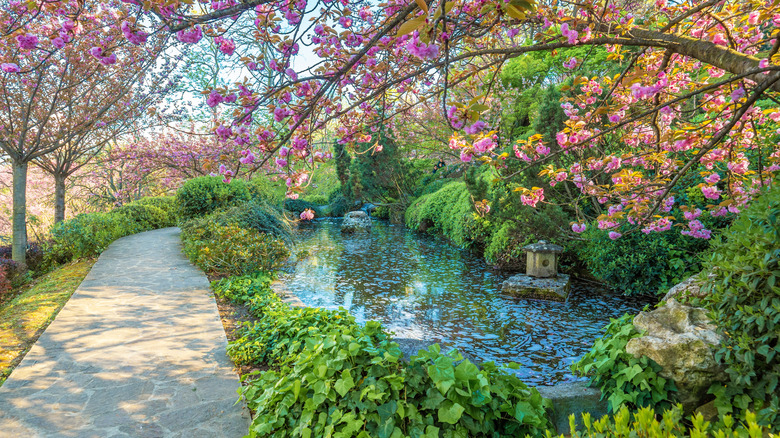
ValerioMei/Shutterstock
Head to the east side of Rome’s Tiber River to find the Botanical Garden of Rome (Orto Botanico di Roma). Relax among the thousands of plant species on the site of a former thermal bath. In the 1600s, seeing as the only botanical garden in Rome was actually in Vatican City, Pope Alexander VII granted the land near the garden’s current location to Sapienza University and asked them to build a botanical garden that would benefit natural studies. In fact, the word “botany” originated in Rome.
The Botanical Garden of Rome is on the Janiculum Hill (Belvedere del Gianicolo). Outside the garden’s western edge is a terrace offering more sweeping views of Rome. A helpful landmark to look for to get this view is the tall Giuseppe Garibaldi Monument (Monumento a Giuseppe Garibaldi). From here, head south on the wooded Passeggiata del Gianicolo street to look for marble busts and to reach Fontana dell’Acqua Paola. If you feel that the famous Trevi Fountain is one of Italy’s tourist traps to skip, this beautiful fountain in Rome’s trendy Trastevere neighborhood is the perfect alternative.
Visit a resilient villa that has been restored to its former beauty
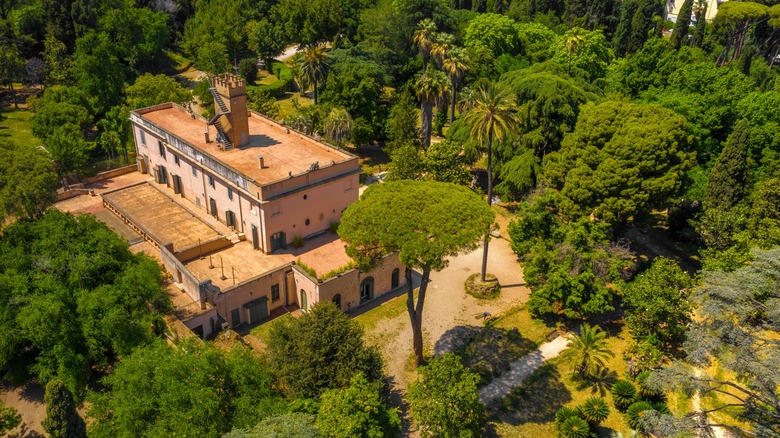
Stefano Tammaro/Shutterstock
Another peaceful spot in the Trastevere neighborhood is Villa Sciarra. Though gardens have been here since Rome’s ancient settlements, the land’s ownership has changed over the centuries. Past owners include a cardinal, wealthy American couple Giorgio Wurts and Henrietta Tower, and even the infamous 20th-century dictator Benito Mussolini. Villa Sciarra’s main structure Casino Barberini suffered damage from wars in the 1800s. But as of the 2000s, Casino Barberini and the villa’s gardens and sculptures across all 7 hectares are well cultivated.
While Casino Barberini is now owned by the Italian Institute of Germanic Studies, the surrounding gardens of Villa Sciarra are free to enter. As you stroll, you will find unique fountains like Fontana con Satirelli e Capretta based on the Roman god Pan, and the Syrian Sanctuary (Santuario Siriaco del Gianicolo), which is believed to be a 4th century shrine. Perhaps the most well-known display in the villa is Exedra of the Twelve Months. These 12 statues are nestled into sharply cut hedges and represent each month of the year.
Villa Celimontana is walking distance from the Colosseum
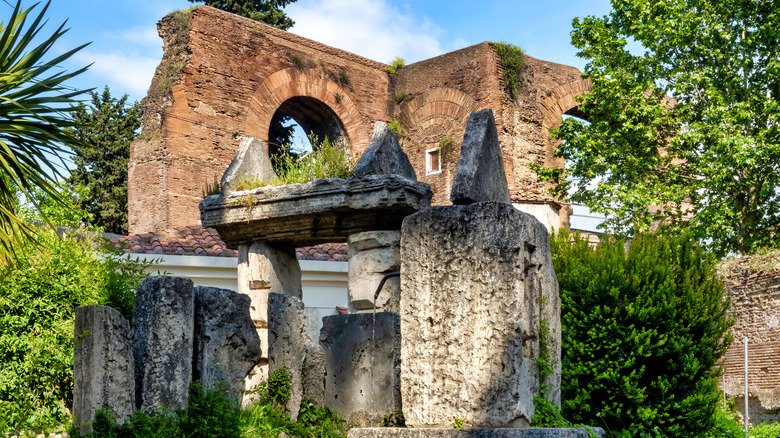
Only_fabrizio/Getty Images
If you want to find tranquil greenery closer to Rome’s most iconic locations, walk to Villa Celimontana just minutes from the Colosseum in a region many wealthy Romans once called home. Look for the Santa Maria in Domnica (Basilica di Santa Maria in Domnica alla Navicella) to enter this villa. Similar to Villa Sciarra, ownership changed over the centuries. Major upheaval of this original vegetable garden occurred in the mid-1500s when Ciriaco Mattei planned to add statues and fountains with the help of fellow architects and artists. His descendants continued to manage and add to the property throughout the 1600s.
Sadly, some of the fountains and sculptures from those formative decades are gone, but the tall Egyptian obelisk that Mattei was gifted still remains along with smaller decorations which have stood the test of time. One of these remaining treasures is the Fontana del Fiume from the 1600s, a fountain that looks like it is straight out of a fairy tale. In true Roman fashion, look for some Aqua Claudia aqueduct ruins around Villa Celimontana as well.

